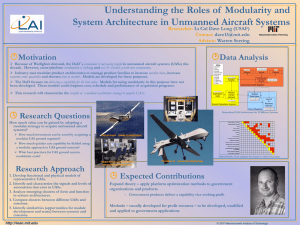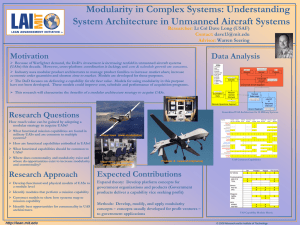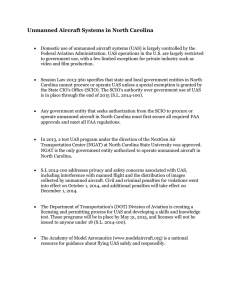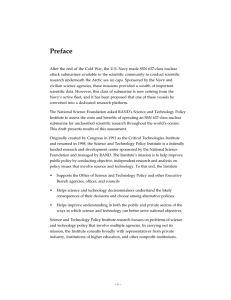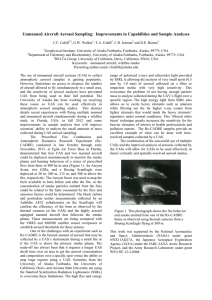6 The RAND Corporation is a nonprofit from
advertisement
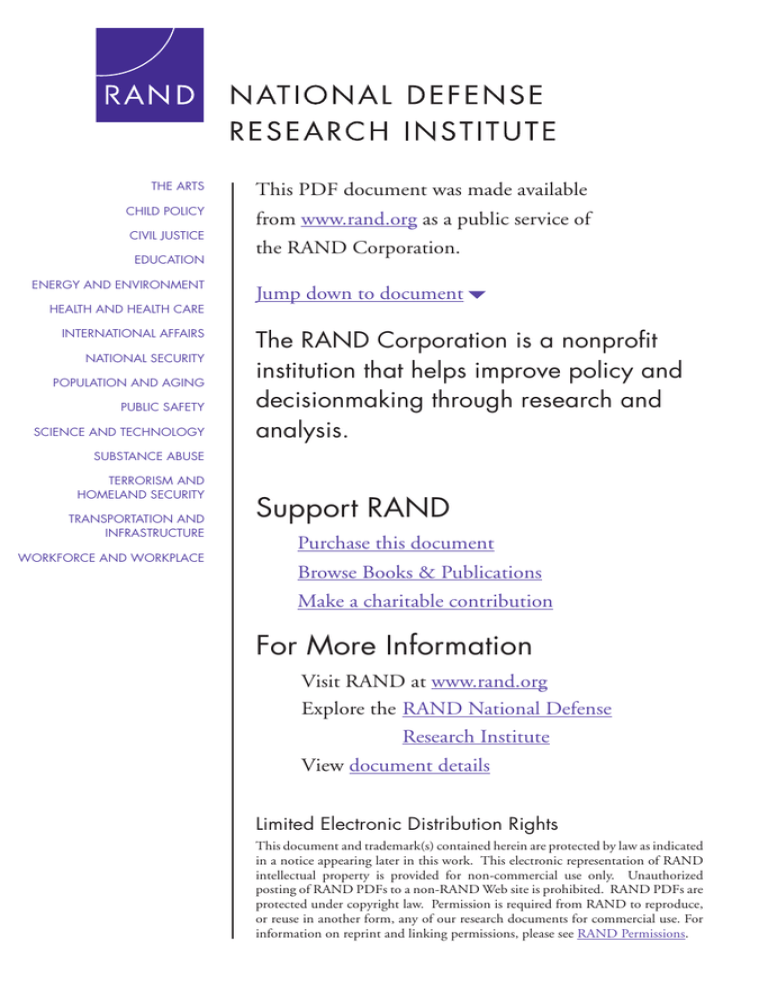
THE ARTS
This PDF document was made available
CHILD POLICY
from www.rand.org as a public service of
CIVIL JUSTICE
EDUCATION
ENERGY AND ENVIRONMENT
HEALTH AND HEALTH CARE
INTERNATIONAL AFFAIRS
NATIONAL SECURITY
POPULATION AND AGING
PUBLIC SAFETY
SCIENCE AND TECHNOLOGY
the RAND Corporation.
Jump down to document6
The RAND Corporation is a nonprofit
institution that helps improve policy and
decisionmaking through research and
analysis.
SUBSTANCE ABUSE
TERRORISM AND
HOMELAND SECURITY
TRANSPORTATION AND
INFRASTRUCTURE
WORKFORCE AND WORKPLACE
Support RAND
Purchase this document
Browse Books & Publications
Make a charitable contribution
For More Information
Visit RAND at www.rand.org
Explore theRAND National Defense
Research Institute
View document details
Limited Electronic Distribution Rights
This document and trademark(s) contained herein are protected by law as indicated
in a notice appearing later in this work. This electronic representation of RAND
intellectual property is provided for non-commercial use only. Unauthorized
posting of RAND PDFs to a non-RAND Web site is prohibited. RAND PDFs are
protected under copyright law. Permission is required from RAND to reproduce,
or reuse in another form, any of our research documents for commercial use. For
information on reprint and linking permissions, please see RAND Permissions.
This product is part of the RAND Corporation monograph series.
RAND monographs present major research findings that address the
challenges facing the public and private sectors. All RAND monographs undergo rigorous peer review to ensure high standards for
research quality and objectivity.
$SSOLFDWLRQVIRU
1$9<810$11('
$,5&5$)76<67(06
%5,(1$/.,5(_-$0(6*.$//,0$1,
3(7(5$:,/621_/28,650225(
Prepared for the United States Navy
Approved for public release; distribution unlimited
NAT IONAL DE FENS E RES EA RC H I NS TI TUTE
The research described in this report was prepared for the United States
Navy. The research was conducted in the R AND National Defense
Research Institute, a federally funded research and development center
sponsored by the Office of the Secretary of Defense, the Joint Staff, the
Unified Combatant Commands, the Department of the Navy, the Marine
Corps, the defense agencies, and the defense Intelligence Community
under Contract W74V8H-06-C-0002.
Library of Congress Cataloging-in-Publication Data is available for this publication.
978-0-8330-4965-0
The RAND Corporation is a nonprofit research organization providing
objective analysis and effective solutions that address the challenges facing
the public and private sectors around the world. RAND’s publications do
not necessarily reflect the opinions of its research clients and sponsors.
R® is a registered trademark.
© Copyright 2010 RAND Corporation
Permission is given to duplicate this document for personal use only, as
long as it is unaltered and complete. Copies may not be duplicated for
commercial purposes. Unauthorized posting of RAND documents to a
non-RAND website is prohibited. RAND documents are protected under
copyright law. For information on reprint and linking permissions, please
visit the R AND permissions page (http://www.rand.org/publications/
permissions.html).
Published 2010 by the RAND Corporation
1776 Main Street, P.O. Box 2138, Santa Monica, CA 90407-2138
1200 South Hayes Street, Arlington, VA 22202-5050
4570 Fifth Avenue, Suite 600, Pittsburgh, PA 15213-2665
RAND URL: http://www.rand.org
To order RAND documents or to obtain additional information, contact
Distribution Services: Telephone: (310) 451-7002;
Fax: (310) 451-6915; Email: order@rand.org
Summary
Background
There has been tremendous growth in demand for unmanned aircraft
systems (UASs) by the United States military since 2001. The United
States Navy is making large investments in a number of major UAS
programs, including Broad Area Maritime Surveillance (BAMS) UAS,
the Unmanned Combat Aircraft System Demonstrator (UCAS-D),
the Fire Scout vertical takeoff/landing tactical UAS (VTUAS), and the
Small Tactical/Tier II UAS (STUAS/Tier II UAS). Navy OPNAV N81
asked RAND to provide an evaluation of the Navy’s ongoing and proposed UAS programs and to describe the most promising applications
of UAS to operational tasks. These assessments were to include arguments for and against using manned vehicles to perform the same tasks
as unmanned vehicles, where appropriate. Completed in September
2008, the study does not provide an exhaustive look at all DoD missions for UAS. It does, however, discuss the strengths and weaknesses
of manned and unmanned aircraft for certain missions of importance
to the Navy. We emphasized traditional Navy missions rather than
Navy contributions to irregular warfare, though we examined a few
nontraditional missions, such as counter-piracy.
Methodology
We evaluated current UAS applications and applications for future
UASs that have been advocated in recent studies and U.S. government
published roadmaps (Ehrhard, 2008; OSD, 2005, 2007; O’Rourke,
xiii
xiv
Applications for Navy Unmanned Aircraft Systems
2006). We characterized UASs currently in use or development by the
Navy, Air Force, and Army. We relied on information gathered during
visits to the contractors that design, develop, and manufacture these
systems to aid us in our characterization. Our primary focus was on
applications for Navy UASs in the 2015–2025 time frame, when several of them will have reached initial operating capability and the Navy
will potentially have an operational unmanned combat aircraft system.
We contrasted the characteristics of these UASs with those of similar
manned aircraft and identified potential advantages and disadvantages
of the UAS in military applications.
For each Navy UAS program, we then identified the applications
that best leveraged the advantages offered by UAS compared with similar manned aircraft, and when possible, we identified ways of mitigating potential disadvantages. We used operational performance as our
criterion rather than financial cost.
This research drew on results from several recent studies of UASs
conducted within RAND Project AIR FORCE. These included a study
of future roles and missions of Air Force UASs led by James Chow, and
multiple studies of maritime surveillance with Global Hawk led by
Sherrill Lingel.
Advantages and Disadvantages of Unmanned Aircraft
Systems
UASs tend to have advantages for applications that are too “dangerous,” “dirty,” “dull,” “demanding,” or “different” to be performed by
manned aircraft:
• Dangerous applications are those involving a high potential for
death or injury to the crew. The advantage of UASs in these applications is that the crew is displaced from the threat.
• Dirty applications are a subset of dangerous applications that
include operating in an environment with dangerous chemical,
biological, radiological, or nuclear materials.
Summary
xv
• Dull applications are repetitive tasks that lend themselves to automation and would otherwise lead to crew fatigue. An advantage
of UASs in these applications is that crew may be rotated without
landing the aircraft.1
• Demanding applications include those that place high demand
on the crew. For example, crew may be the limiting factor in
high-endurance applications or those subjecting the aircraft to
high g-forces. Demanding applications may also include those
that place high demands on aircraft performance. Eliminating
the weight and volume associated with a crew provides additional
degrees of freedom in aircraft design, potentially enhancing aerodynamic performance.
• Different applications are those that are not feasible for manned
aircraft. For example, small hand-launched UASs can provide
quick input to organic intelligence, surveillance, and reconnaissance (ISR) and aid in providing situational awareness for Marines
in the field; it may be difficult or infeasible to provide rapid access
to these capabilities using manned aircraft.
There are also potential disadvantages in using UASs. We found
that the most important disadvantage stems from their reliance on
communication resources to connect the UAS to offboard operators
and analysts.2 High data rates, especially, are associated with sensors
that provide imagery for ISR applications and may be on the order of
tens to hundreds of megabits per second. For UASs, this information
must be transmitted to offboard crew, and the data links may be vulnerable to attack. This is especially true for satellite communication
1
It may be possible to cut back crew requirements for applications that are well suited to
automation. For instance, a UAS operating as a communication relay may not require a dedicated pilot at all times. It might be possible, for example, to have one pilot controlling many
communication relays except during takeoff and landing.
2
We also evaluated their dependence on GPS for position, navigation, and timing. We
found that UAS and manned aircraft reliance on GPS is similar: Both rely on it for navigation, precision targeting, sensor and antenna pointing, and synchronization. Manned aircraft crew can aid in these tasks using their senses and decisionmaking capabilities. To some
extent this can be done on a UAS by adding sensors and onboard processing capability, but
it places additional burden on communication resources.
xvi
Applications for Navy Unmanned Aircraft Systems
uplinks, which are vulnerable to noise jamming and kinetic threats.
Also, applications in high-threat environments may require stealth
for aircraft survival, and the active emissions necessary to connect the
UAS to offboard crew make the UAS more susceptible to detection
and, ultimately, attack. It is often desirable to send information from
manned aircraft, too, but there is the option of exploiting the data
onboard the aircraft—or at least filtering what information must be
sent. Data-compression techniques can reduce the data-rate requirements, but at the expense of increased distortion in the data products. Technologies such as automatic target classification can also help
reduce the data-rate requirements, but many of these technologies are
still only in the laboratory and not yet ready for the battlefield.
Recommended Applications for Navy Unmanned Aircraft
Systems
We made a detailed evaluation of options for an operational Navy
Unmanned Combat Aircraft System (N-UCAS) and a broader evaluation of applications for other Navy UAS.
Airborne communication relays mitigate kinetic and noise jamming threats to satellite communication uplinks by providing an alternative set of links either directly to surface-based terminals or to satellites beyond the range of threats. They are less susceptible to noise
jamming threats than satellites because an adversary has to detect, geolocate, and track the airborne asset and operate within line of sight
of the receive antenna main beam. High-altitude, long-endurance
UASs are particularly well suited to communication relay applications
because high altitude extends the line of sight (LOS) and long endurance allows the communication link to be sustained for long durations.
For these reasons, and since UASs are often highly dependent on satellite communication resources, we feel that communication relay is an
important application for Navy UASs. We developed an operational
concept for a theater relay system to provide communication resources
to fleet assets, including other UASs. This system consists of two air-toair links and an air-to-satellite link to provide connectivity to a satellite
Summary
xvii
beyond LOS of jamming and kinetic threats. We also evaluated the
design characteristics of communication relay equipment that would
be needed.
We made a detailed evaluation of several potential applications
for an operational N-UCAS that would follow successful demonstration of carrier capabilities for a low-observable (LO) design using
UCAS-D (expected to be complete by fiscal year 2013).3 The LO characteristics of UCAS-D make it well suited to applications in highthreat environments. Long-range and endurance attributes may give
it advantages over manned aircraft, such as F-35C, for similar applications. However, as noted, reliance on communication resources is
a disadvantage compared with manned aircraft. For this reason, we
evaluated the communication requirements and examined the vulnerabilities that may result. We feel that development of low probability of
intercept (LPI) tactical data links can mitigate many potential vulnerabilities and enable N-UCASs to support applications in high-threat
environments. While there are ongoing efforts to develop LPI tactical
data links—for instance, tactical targeting and networking technology
and multifunction airborne data link—those efforts are focused on the
needs of manned aircraft, not UASs. These observations led to our
recommended applications for N-UCASs, but they are not the only
observations that are described in detail in the monograph. Our evaluation of applications for the N-UCAS is summarized in the stoplight
chart of Table S.1.
The Fire Scout VTUAS has an operational footprint that is a
fraction of that of the multipurpose MH-60-class helicopters; it can
operate from, and provide the UAS advantages to, surface ship platforms. Until recently, the Navy’s testing and development of Fire
Scout was closely tied to the evolution of the Littoral Combat Ship
(LCS) program. Because of serious delays in the LCS program, the
Navy decided to conduct operational testing on another vessel. With
an electro-optical turret equipped with a laser designator and a small
3
By low-observable, we mean that passive signature reduction techniques, such as fuselage
shaping and the use of radar-absorbent materials, may be applied. However, we do not mean
to exclude the possibility that active signature reductions would also be applied.
xviii
Applications for Navy Unmanned Aircraft Systems
Table S.1
Evaluation of Applications for the N-UCAS
Application
Advantages for
N-UCAS
Disadvantages for
N-UCAS
Penetrating
strike
Range, stealth, no
danger to crew
Vulnerability of C2 data
links
LPI data links
could reduce
vulnerability
Penetrating
ISR
Range, stealth, no
danger to crew
Vulnerability of data
links for ISR products
LPI data links
could reduce
vulnerability
COMINT
collection
Stealth
Large number of
antennas required is
detrimental to stealth
Useful secondary
mission for
high-threat
environment
ELINT
collection
Stealth
Antennas required are
detrimental to stealth
Low data rate
required for
transmittal of
data
Air-to-air
combat
Range, stealth, no
danger to crew,
g-forces
Latency; vulnerability of Not useful
C2 and sensor data links in dogfight;
manned/
unmanned less
ambitious
Airborne
electronic
attack
Stealth, range
Self-jamming; POD
weight/power; LO
compromised
Potentially
useful in niche
applications
SEAD
Close approach
reduces kill-chain
Limited airborne
electronic attack
capabilities
Weaponized
platform
for niche
applications
Close air
support
Range, stealth
UASs already
do it
CBRN
detection
Range, stealth, no
danger to crew
Accommodating sensors
in stealth design and
decontamination of
aircraft are challenging
Sample collection
may be good
application for
STUAS
Comments
NOTE: See the Abbreviations section for all acronyms.
surface search radar, the MQ-8B could provide a wide spectrum of
surface vessels with an over-the-horizon maritime surveillance capability. Further, the Fire Scout has sufficient payload capacity to provide
for a modest armament. Armed variants of Fire Scout could be used to
Summary
xix
interdict in a variety of small-boat threats. The Army plans to procure
a variant of Fire Scout as its Class IV UAS for a Future Combat System
(FCS) program during the middle of the next decade. Also, the U.S.
Coast Guard is interested in Fire Scout as a sea-based surveillance platform. This provides the opportunity for a rather robust production run
of a UAS vehicle family and may provide the Navy, the Coast Guard,
and the Army with lower overall production costs.4
The A160T Hummingbird is a VTUAS under development by the
Defense Advanced Research Projects Agency (DARPA) and Boeing.
Flight tests are scheduled through the end of the decade. Although the
aircraft is much larger than the Fire Scout with a footprint closer to
that of the MH-60, it is expected to have higher altitude and payload
performance.
The goal of the Navy and Marine Corps Small Tactical UAS/Tier
II UAS (STUAS/Tier II UAS) program is to provide persistent ISR support for tactical-level maneuver decisions and unit-level force defense
and protection for Navy ships and Marine Corps land forces. For the
Navy, it may provide UAS operational capabilities to surface ships that
are unable to support a larger platform such as Fire Scout. ScanEagle is
one potential candidate for STUAS; it offers limited ISR capabilities in
a high-endurance platform that can be launched and recovered from a
wide spectrum of ships. STUASs may also be useful in chemical, biological, radiological, and nuclear (CBRN) applications—in particular,
for detection, plume tracking, and collection of samples for offboard
analysis after CBRN materials have been released due to an attack on
a suspected CBRN weapon site.5
Study Recommendations
We recommend communication relay as an application for Navy UASs.
Communication relay mitigates kinetic and noise-jamming threats to
4
5
The FCS program was cancelled prior to publication of this monograph.
Boeing and a team of U.S. biodefense companies were awarded an $8.2 million contract
by the Defense Threat Reduction Agency (DTRA) in 2006 to develop a biological combat
assessment system for ScanEagle (“ScanEagle to Detect Biological Agents,” 2006).
xx
Applications for Navy Unmanned Aircraft Systems
satellite communication uplinks. This will benefit fleet assets that are
highly dependent on satellite communication resources, including other
UASs. The BAMS UAS is particularly well suited to the communication relay application because of its high-altitude and long-endurance
attributes, and the Navy has considered this application for the BAMS
UAS.6 However, a communication relay payload would compete for
size, weight, and power needed for BAMS UAS sensors to support its
primary role in providing ISR. This could be addressed by developing a modular payload capability for the BAMS UAS so that it could
either be configured with multiple sensors to support its primary ISR
roles or configured with a communication relay and fewer sensors for
a more limited ISR role. Another alternative is to use the BAMS UAS
for the air-to-air links only, and another platform, possibly a manned
platform, for the air-to-satellite link. The air-to-air links require much
less payload power than the air-to-satellite link, making more power
available for sensors.
We recommend that the Navy support efforts to develop robust,
LPI tactical data links, and to orient those efforts to meet the specific
needs of the UAS. Development of this technology could be an enabler
for LO UASs, such as the N-UCAS.
We recommend penetrating strike, suppression of enemy air
defenses, close air support, and electronic intelligence (ELINT) collection as primary applications for the N-UCAS. We recommend that
the Navy not invest in developing air-to-air combat capability for the
N-UCAS because it will likely be less effective than manned aircraft
in this application (in the 2015–2025 time frame). We also recommend that the Navy not invest in CBRN detection applications for
N-UCASs because of the challenge of incorporating a suitable sensor
into a stealthy design, and challenges associated with decontamination of the UAS upon recovery on an aircraft carrier. CBRN detection
and tracking may be a promising application for other UASs, such as
STUAS, but not for N-UCAS specifically. We see limited utility for the
6
Low-rate initial production vehicles are likely to include a basic communication relay
package that leaves space for spiral development of a more capable communication relay
package. See Richfield, 2007.
Summary
xxi
N-UCAS in penetrating ISR, comunication intelligence (COMINT)
collection, and airborne electronic attack applications.
If the UCAS-D program is successful in addressing many of the
challenges of operating UASs from carriers, we recommend the Navy
consider development of nonstealthy, carrier-capable, medium-altitude,
and medium-endurance UASs. The Army and the Air Force have realized tremendous operational advantages with this class of UAS (though
they are not carrier-capable) for strike missions against time-sensitive
targets. Operating similar UASs from carriers would be particularly
advantageous in conflicts where carriers can be among the first assets
on scene to project power and where access to air bases is limited. While
the N-UCAS could be used for the same applications, it may not be the
most cost-effective platform when operating in a benign environment
where LO characteristics are not needed. If the UCAS-D program is
successful in addressing the challenges of operating UASs from carriers, we recommend the Navy consider a mix of stealthy N-UCASs and
potentially lower-cost nonstealthy UASs to meet its mission needs.
The Navy and the Marine Corps are currently leasing STUASclass aircraft. For the Navy, the STUAS could support maritime interdiction operations by providing information about numbers of personnel aboard a vessel. It could be used to extend LOS communication
range or to track vessels in support of counter–small boat attack or
counter-piracy missions. STUASs may also be useful in CBRN applications, in particular for detection, plume tracking, and collection of
samples for offboard analysis after CBRN materials have been released
due to an attack on a suspected CBRN weapon site. Larger and morecapable platforms designed for a broader range of applications, such as
Fire Scout, could be used for many of the applications envisioned for
the STUAS. However, they would not operate from the same broad
range of Navy ships and may not be cost-effective in these specific
applications. If these applications are important to the Navy, then the
STUAS/Tier II UAS program to acquire, own, and operate these platforms should move forward.
